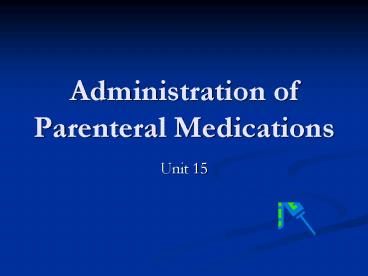Administration of Parenteral Medications - PowerPoint PPT Presentation
1 / 16
Title:
Administration of Parenteral Medications
Description:
Demonstrate the proper procedure to be used when giving a ... not irritate the ... medications that can be irritating to subcutaneous tissue ... – PowerPoint PPT presentation
Number of Views:1445
Avg rating:3.0/5.0
Title: Administration of Parenteral Medications
1
Administration of Parenteral Medications
- Unit 15
2
Objectives
- Give three advantages of the parenteral route of
drug administration - List the basic guidelines for administering an
injection - Prepare a patient for an injection
- Demonstrate the proper procedure to be used when
giving a subcutaneous, intramuscular,
intradermal, and a Z-track intramuscular
injection.
3
Parenteral Route
- Rapid
- Produces a direct result
- Drugs are absorbed directly into the bloodstream
- Types of injections
- Intravenous fastest effects
- Intramuscular next fastest result
- Subcutaneous slower than other two
4
Advantages of Parenteral Route
- 3 major advantages include
- Effective route for drug delivery when the
patients physical or mental state would make
other routes difficult - Do not irritate the digestive system
- Can deliver a precise dose to a targeted area of
the body (i.e. into a joint or within the spinal
canal)
5
Disadvantages of the Parenteral Route
- Possible disadvantages include
- Patient may have allergic reaction
- Introduction of microorganisms
- Injections can cause injury to tissue, nerves,
veins, and other vessels - Needle can strike a bone
- Injections can traumatize a vein and cause a
possible hematoma
6
Preparing Patient for Injection
- 1. Establish rapport with the patient
- 2. Let the patients ask questions
- 3. Ask the patient to relax the area that is to
be used for the injection - 4. Inform the patient that he/she will feel a
slight stick - 5. NEVER tell a patient that the injection will
not hurt (especially children)
7
Patient Assessment
- Before administering any medication, you assess
the patient. Your assessment should include - Age
- Physical condition
- Body size
- Sex
- Injection site
8
Injection Site Selection
- Subcutaneous injection given at a 45 degree
angle, just below the surface of the skin - Intramuscular injection given at a 90 degree
angle, passing through the skin and penetrating
into the muscle tissue - Intradermal injection given at angle between 10
and 15 degrees within the epidermal layer of the
skin
9
Guidelines for Administration of Injections
- Adhere to the six rights of drug administration
- Select a needle-syringe that is the appropriate
size - Prepare the proper equipment
- Select the correct site for the injection
- Prepare patient for injection
- Inject medication slowly into patient
10
Special Methods
- Z-track method used for administering
medications that can be irritating to
subcutaneous tissue - Ex. Iron dextran/hydroxyzine HCL should be
administered using this method - Involves pulling the skin in a way that the
needle track is sealed off after the injection
11
Intravenous (IV) therapy
- IV therapy administration of fluids, solutions,
electrolytes, nutrients, or medications through
the venous system - MAs are NOT permitted to administer IV
medications or to perform IV therapy - Types of IV infusions include crystalloids,
colloids, solutions, hypertonic preparations, and
blood/blood components.
12
Types of IV Infusions
- Crystalloids materials capable of
crystallization or can form crystals usually
electrolyte solutions - Types of electrolyte solutions
- isotonic increases extracellular fluid volume
- Hypotonic forces fluid into the cells (water
intoxication) - Hypertonic draws fluid out of the cells causing
cellular dehydration
13
Types of IV Infusions
- Colloids gluelike substance whose particles
remain uniformly distributed and do not form a
true solution - Hydrating solutions administered to patients to
supplement caloric intake and supply nutrients - Blood/blood components life-sustaining
constituents
14
Advantages of IV therapy
- Some advantages include
- Direct route for immediate delivery
- Reliable route for the unconscious or
uncooperative patient - Absorption of the drug is directly into the
bloodstream
15
Disadvantages of IV therapy
- Some disadvantages include
- Fluid overload circulatory system is overloaded
with excessive fluids - Air embolism obstruction of a blood vessel by an
air bubble - Septicemia pathogenic organisms are introduced
into the patients bloodstream
16
Disadvantages of IV therapy
- Infection local and systemic
- Thrombophlebitis blood clot in the vein
- Hematoma leakage of blood into surrounding
tissues - Pain burning or stinging sensation
- Hypersensitivitiy reaction patient may be
allergic to the IV materials or the medication
itself anaphylactic shock































